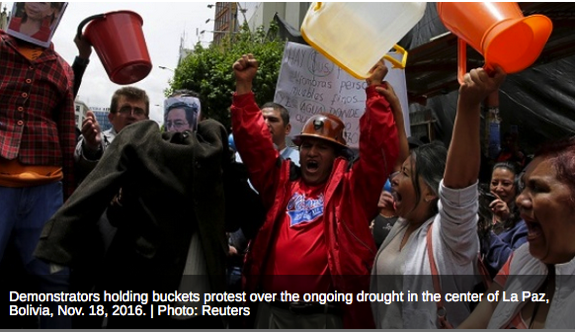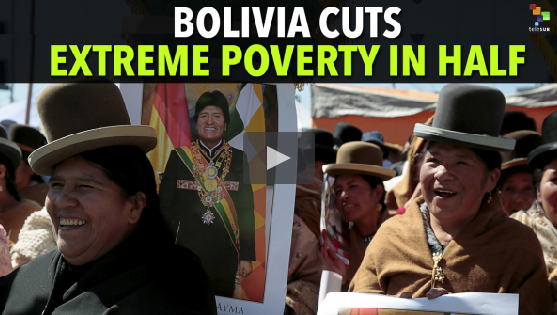
Water Rations Tightened as Severe Drought Parches Bolivia
November 20, 2016 - telesurtv.net
Water scarcity has sparked protests and road blockades in the countries largest cities.
Bolivia's worst water crisis in 25 years has pushed authorities to declare indefinite water rationing in La Paz to ease the impacts of a parching drought that's led to scarcity in five of the South American country's nine departments.

OPINION:
Fifteen Years of Community Controlled Water in Bolivia
Over 90 communities in the highland city have been under water rationing measures for nearly two weeks that have turned off taps for up to 60 hours at a time before being turned back on for a 12 hour period.
Despite the strict rationing affecting some 340,000 residents, the threat of severe scarcity still looms large. In the main three dam reservoirs feeding La Paz, water levels in two have only crept up to 8 percent, while the third is in a danger zone with just 1 percent of its water capacity.
Rations have also been announced in other cities including El Alto, Cochabamba, Potisi and Sucre while President Evo Morales has called for responsible water use across the country.
The measures have ignited unrest among frustrated residents. Community leaders reportedly kidnapped and held hostage water authorities from the city of El Alto for three hours Thursday — including the vice minister of water Ruben Mendez, the regional director of the public water company Epsas Roberto Rojas and at least six other officials — when Minister of Water and the Environment Alexandra Moreira was a no-show for a meeting on the crisis. Protesters have also hit the streets in Cochabamba and La Paz in recent days.
Amid the crisis, water quality is also a concern.
ANALYSIS:
Bolivian Independence from the World Bank and IMF
"We need water," local La Paz resident Virginia Lopez told Reuters, explaining the cuts and high bills. "But the water is dirty, yellow, and now the dirty water is what we have to drink."
A study by Bolivia's health authorities recently found that just six pecent of makeshift wells residents have drilled on their own in the face of scarcity meet safe drinking water requirements. And the majority of water trucks that deliver privately sourced water around La Paz — 331 out of 400 such trucks in the city — have proper licensing for the service.
Meanwhile, rising rates for the basic sanitation services amid scarcity is sparking fears of increased inequality and brewing the conditions for renewed water wars in the country, like the ones that rocked Cochabamba in 2000 to resist the privatization of precious water resources.
One of the main causes behind the crisis is climate change. Global warming threatens to melt the country's Andean glaciers in the coming years after already shrinking the ice caps by 30 to 50 percent since 1970s, according to researchers. According to the United Nations, Bolivia is one of the most vulnerable countries in the face of climate change.
The particularly strong El Niño climatic effect in the last season — which, together with raging climate change, has put 2017 on track to smash the record as the hottest year — has worsened the drought parching Bolivia.
Many have also raised questions about the role of Bolivia's mining and extractive sector in worsening the impacts of climate change. The country's second largest lake, Lake Poopo, dried up last year, and although researchers pointed to climate change as a key factor in the disaster, the local mining industry is also thought to have exacerbated the problem by leading to the build up of contaminated sediment deposits in the lake.
Bolivia's Aymara people have worshipped the Andean glaciers since time immemorial as the givers of life sending water down from the mountains.
